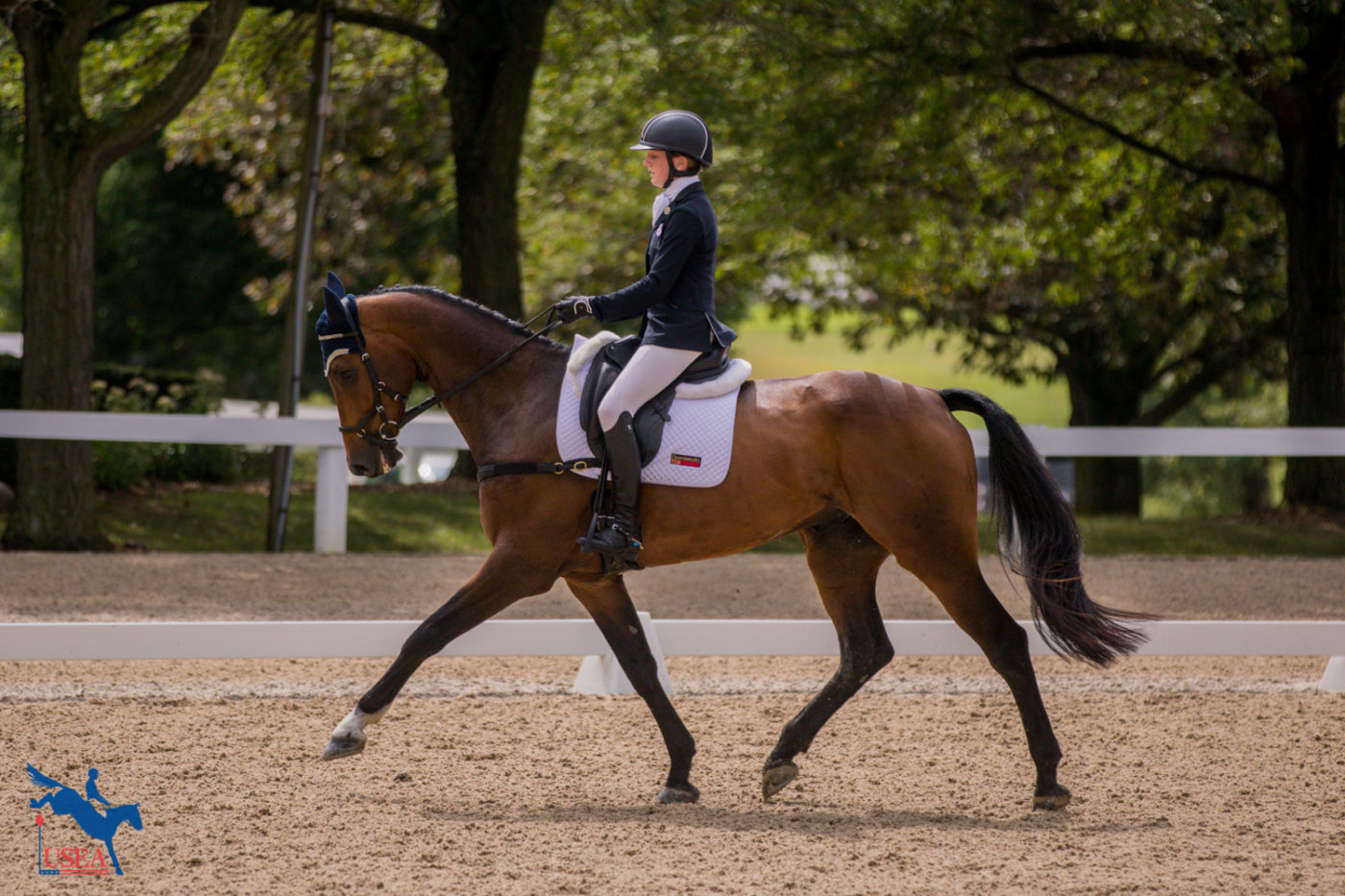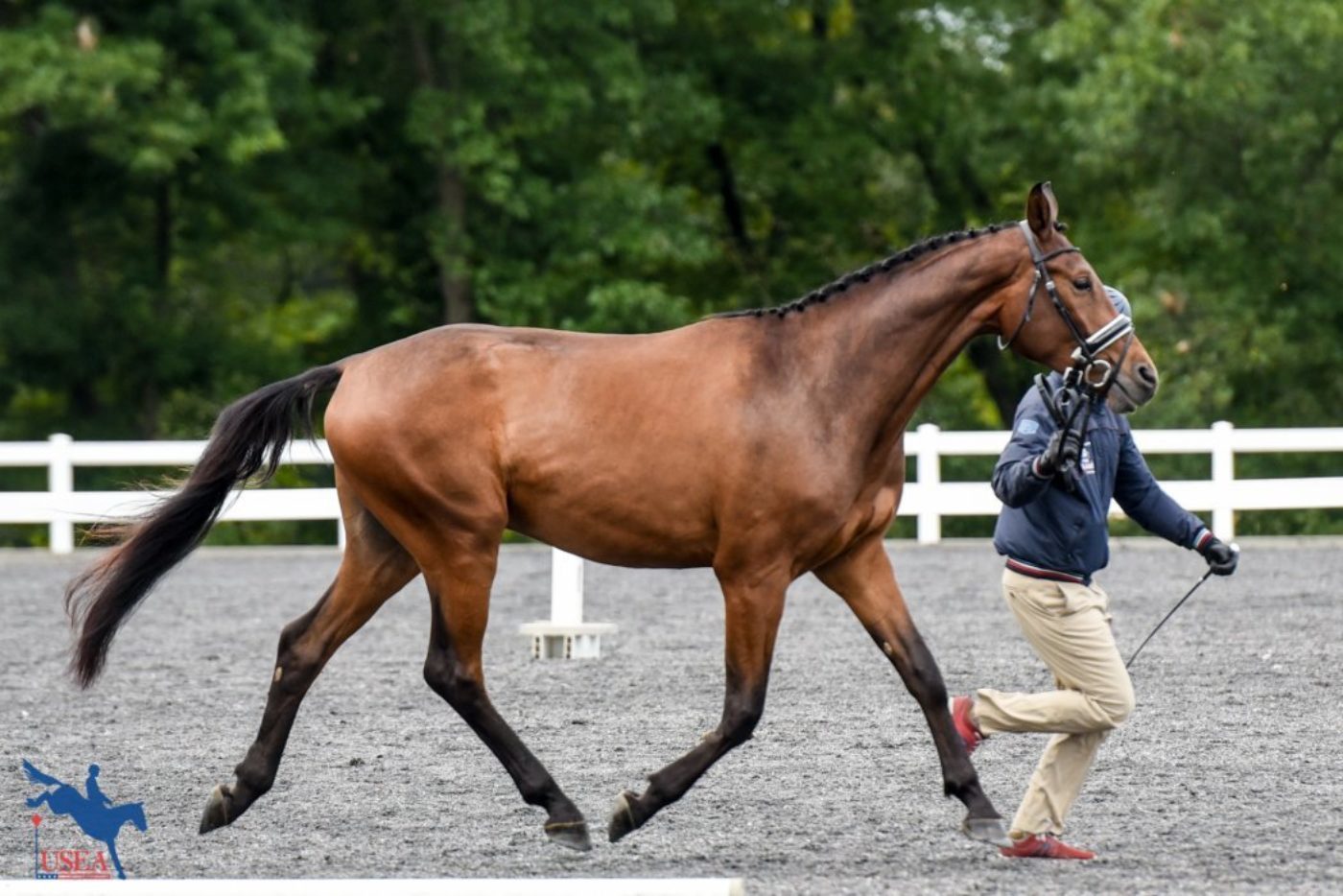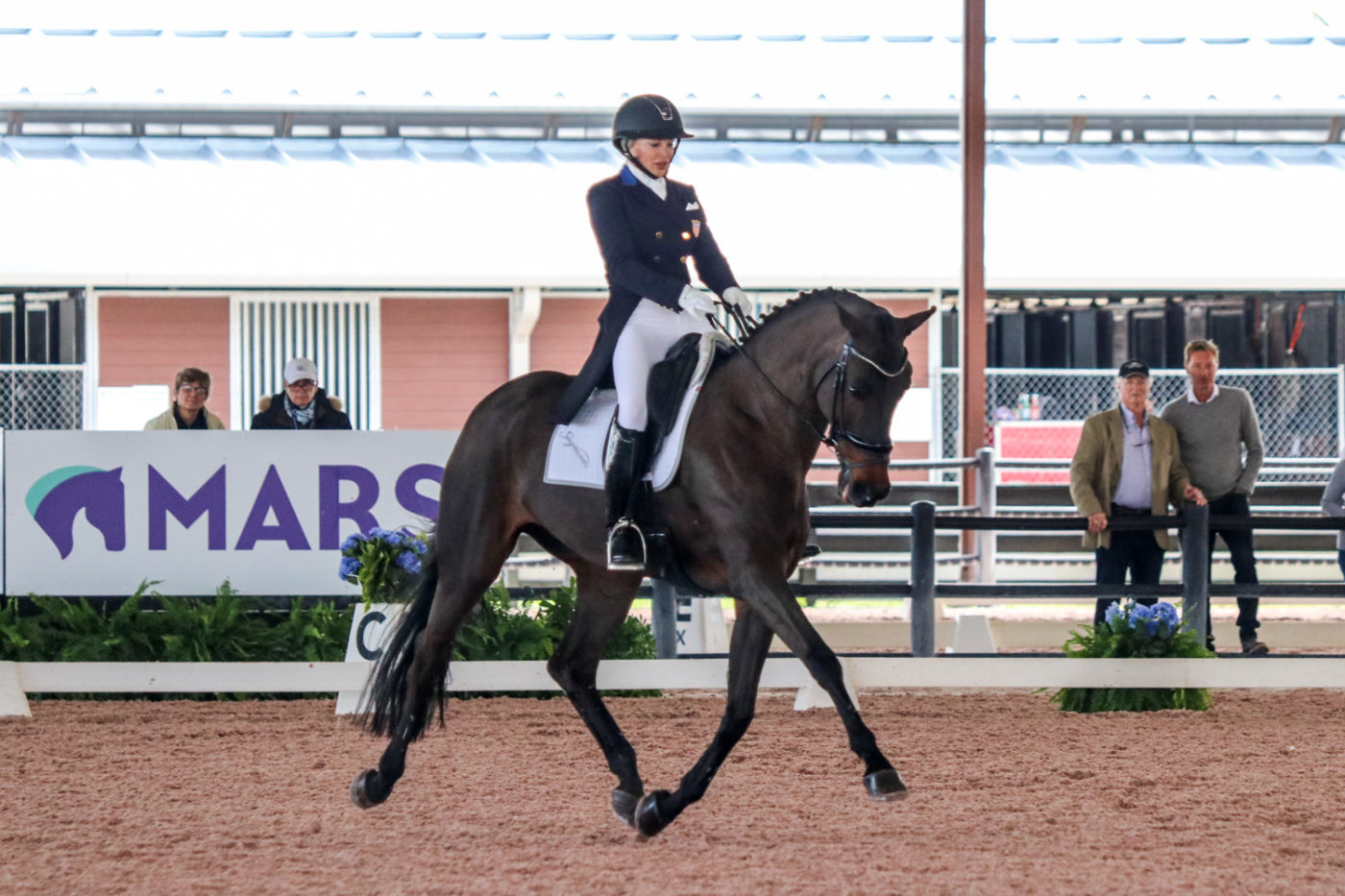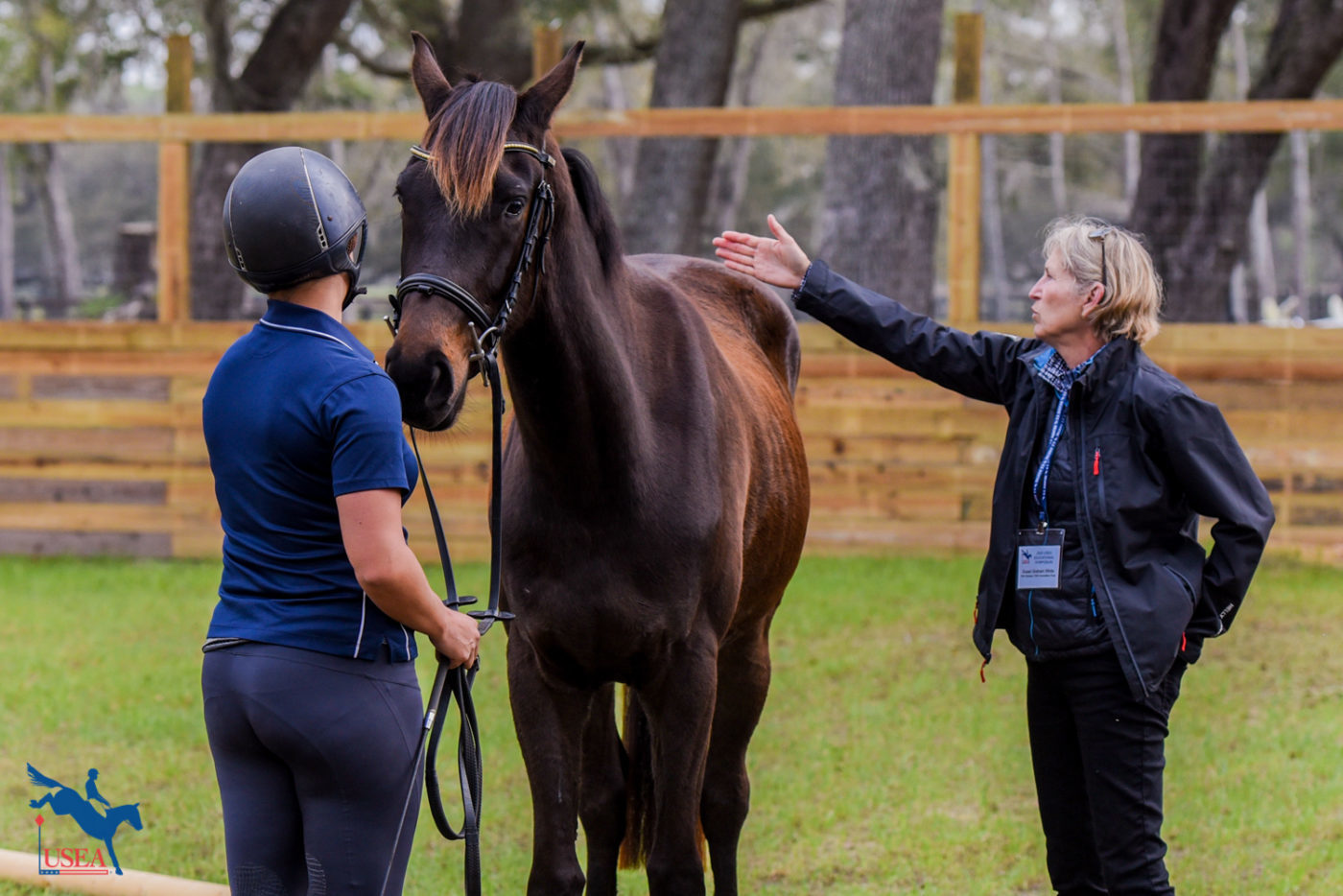

“Correct movement is not the same as scopey or extravagant movement,” said Susan Graham White, who has years of experience judging international event horses as well as future event horses. White, a USEF ‘S’ Eventing Judge, a Level 3 FEI Eventing Judge, and the Co-Chair of the USEA Future Event Horse (FEH) Committee, explains correct and flashy movement in event horses. “Correct [movement] is the structural and inherent base that should be looked for in any event horse, if it is to be a successful triathlete. ‘Flashy’ should be a positive comment that implies good coordination of body and scopey movement.”
Correct Movement
A horse’s movement affects their soundness, longevity, and level of success as an event horse – and a horse with correct movement is key. “Correct movement usually refers to the flight of travel of the horse’s legs while it is moving. It also broadly means the correct sequence of footfalls in each gait, i.e. a four-beat walk, a three-beat canter, [and a] two-beat trot. It is desirable to have the horse travel in a way that it will not interfere with itself, or put undue strain on parts of the anatomy. So, if a horse wings, paddles (in front), or twists (behind) it will have some effect on long term soundness. How much effect depends on the degree of deviation and, of course, on training factors. A horse can be a correct mover and still have average gaits. [But] gaits can improve with good training!”

Flashy Movement
Flashy movement can certainly attract attention, but is every flashy mover a correct mover? White explained, “the term ‘flashy’ mover has been used loosely in the equestrian world and can have different interpretations in various disciplines. Sometimes a sport horse is described with ‘flashy’ movement because it throws the front legs out in an extreme way in the trot. While it is a good thing for a horse to have a free shoulder and be able to reach with the front legs, for the movement to be correct it should be equally supported behind. Otherwise there can be the appearance of the horse ‘flicking’ its front feet. Some of this can be influenced by training techniques and some from a less than uphill conformation.”
“A horse can be both correct and flashy. In the modern sport horse this quality movement comes from solid conformation, correct gaits, and good training. A prime example [of both a correct mover and flashy mover] would be the Oldenburg mare, RF Scandalous.” RF Scandalous (Carry Gold x Richardia) is a 15-year-old Oldenburg mare ridden by Marilyn Little, owned by Raylyn Farms, and bred by Horst Buhrmann. The Oldenburg mare has earned top finishes in five-star events including a 4th place finish at Luhmuhlen CCI5*-L in 2017 and a 3rd place finish at the Land Rover Kentucky Three-Day Event in 2018. She also has over 18 wins to her USEA record which includes the individual gold medal at the 2015 Pan American Games.

Judging Movement
From proven five-star event horses to yearlings, movement is judged at every level of eventing. In a FEH competition, the yearlings, 2-year-olds, and 3-year-olds are judged in-hand at the walk and trot. The FEH 4-year-olds are judged under saddle at the walk, trot, and canter. So, how do FEH judges judge correct movement in young horses? “We want to see that the walk is a clear four-beat walk and that the horse naturally wants to use its topline, show freedom through the shoulder, and cover ground. We’re looking for a horse that wants to have a longer walk because we believe the walk translates biomechanically to the canter.”
In the trot, “we’re looking for a clear two-beat trot. We’re looking for the horse to show scope with a natural balance and uphill tendency. We don’t want a high knee action, and we would rather see horses that move out rather than upward in front. Although, we still want a good use of the hind end to lift them off the ground.”

The overall type of horse that a FEH judge is looking for is a “tri-athletic type, which is a refined horse, with enough speed and endurance to do the upper levels and enough scope in its movement to show the extended and medium paces. If you were looking for a dressage type, you would look for a horse that is a lofty mover that would be able to piaffe and passage but, that’s not the kind of movement that lends itself to a big, ground-covering gallop. The tri-athletic type has to sit somewhere in between a sport horse type and dressage type of horse.”
For further details on horse movement and FEH judging, please watch this video.
The USEA introduced the Future Event Horse Program in 2007 in response to the popularity of the already established USEA Young Event Horse Program. Where the YEH program assesses 4- and 5-year-old prospective event horses based on their performance, the FEH program evaluates yearlings, 2-year-olds, 3-year-olds, and 4-year-olds for their potential for the sport based on conformation and type. Yearlings, 2-year-olds, and 3-year-olds are presented in-hand while 4-year-olds are presented under saddle at the walk, trot, and canter before being stripped of their tack and evaluated on their conformation. Divisions are separated by year and gender. At the Championships, 3-year-olds and 4-year-olds are also required to demonstrate their potential over fences in an additional free-jump division. Click here to learn more about the Future Event Horse Program.
The USEA would like to thank Bates Saddles, Parker Equine Insurance, SmartPak, Standlee Hay Company, C4 Belts, Etalon Diagnostics, and Guardian Horse Bedding for sponsoring the Future Event Horse Program.
Great Britain’s Yasmin Ingham and Banzai du Loir found themselves in a familiar position today at the top of the leaderboard after dressage at the Defender Kentucky Three-Day Event, scoring a 26.0. A year ago, Ingham and “Banzai” led the field heading into cross-country after Friday’s dressage, but they drew an earlier start this year, and Ingham’s got a few more challengers to come tomorrow.
In comparison to many of his other upper-level event horses, Commando 3, or “Connor” as he is known in the barn, is still a newer ride for Boyd Martin, but that hasn’t held the pair back.
Are you following along with the action from home this weekend? Or maybe you're competing at an event and need information fast. Either way, we’ve got you covered! Check out the USEA’s Weekend Quick Links for links to information including the prize list, ride times, live scores, and more for all the events running this weekend.
Let the fun and games begin! This morning kicks off the official start of competition at the 2024 Defender Kentucky Three-Day Event (K3DE). The hefty four-star field is the first to set foot in the Rolex Stadium starting at 8:00 a.m. Last year we saw 49 four-star pairs in this division, but this year there are 63 pairs in the field.